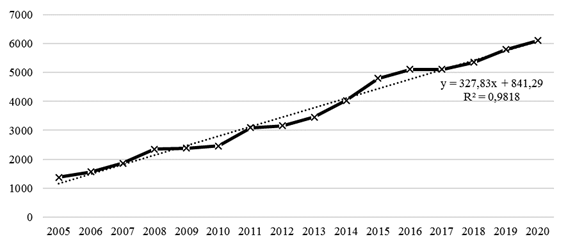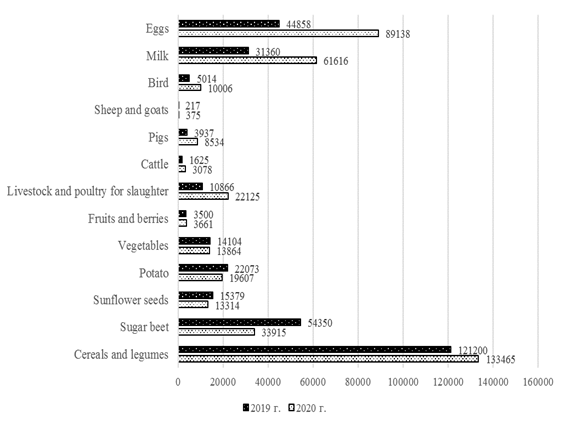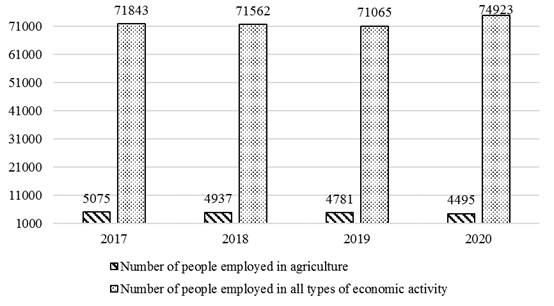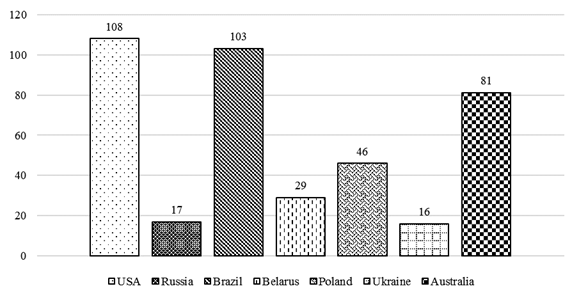Abstract
The issues of development of the agricultural sector of the economy of the Russian Federation are considered. Agriculture is one of the main and most important sectors of the national economy, ensuring the country's independence in addressing issues of supplying the population with high-quality food. The sanctions imposed by European countries have shown the vulnerability of the Russian agro-industrial complex in provision of the population with the necessary food products. The level of development of agriculture in Russia lags behind a number of countries, which is reflected in low labor productivity, lack of funding for scientific research, the introduction of modern digital technologies; however, the huge sown areas, favorable conditions for the production of agricultural products, provide the country with a high level of its potential in this area. The transition of the industry to modern resource-saving and intensive technologies will allow for a significant increase in agricultural products, an increase in labor productivity, an increase in the economic efficiency and attractiveness of the industry, which will have a positive effect on the revival of rural areas, ensuring high-quality living conditions for villagers, increasing the rural population and improving the well-being of citizens. The use of all available opportunities aimed at expanding the agricultural sector will have a positive impact not only on citizens of the Russian Federation, but also on citizens of other countries, as consumers of high-quality and environmentally friendly products.
Keywords: Agriculture, development, economy, innovation, prospects, state
Introduction
Agriculture is the first industry with which man met on the path of his evolutionary development. Providing family members with food is the main task of the life of any person. The development of society made it possible to shift part of the function for the production of agricultural products from the individual to agricultural enterprises, organizations and complexes. In order to obtain the necessary foodstuffs, modern man no longer strives to cultivate the soil or take care of farm animals, he buys it in stores and supermarkets. Thus, the issues of food provision fall on the organizations specializing in this type of activity. The development of agricultural enterprises, as well as enterprises engaged in the processing of agricultural products, are becoming especially important in the economy of any state. The level of development of agricultural enterprises determines not only the provision of citizens with the necessary set of food, but also its assortment, quality, presentation and properties. The government at all levels is interested in the development of these organizations, since organic food is necessary not only for an ordinary citizen, but also for any official. Efficient agriculture, processing of agricultural products and storage provide favorable conditions for the life of the population, its prosperity, harmonious and healthy development.
Problem Statement
In the past few years, high and volatile food and agricultural commodity prices, as well as fears of a pandemic, rising per capita food demand and environmental constraints have pushed agriculture to the top of Russia's political agenda. The development of the agricultural sector was facilitated by the government's decision to introduce countermeasures by banning the import of agricultural products to Russia, as a response to the EU's decision to impose sanctions against Russia following the annexation of Crimea in 2014. The ban is actually protectionism. This measure allowed to attract additional investment in agriculture in order to ensure food security and provision of the population with high-quality food of its own production. Thanks to the policy pursued, the agri-food sector has become one of the most steadily developing sectors of the national economy.
Research Questions
Agriculture of the Russian Federation is the largest sector of the economy. In the structure of added value, the industry in 2020 amounts to more than 6% with an annual tendency to increase. More than 53% of agricultural production is accounted for by crop production. The main producers of crop products are concentrated in the Krasnodar Territory, Rostov and Voronezh Regions, Stavropol Territory, Volgograd Region and the Republic of Tatarstan. They account for more than 30% of all crop production. Livestock raising is developed in the Belgorod and Chelyabinsk regions, the republics of Tatarstan and Bashkortostan, the Krasnodar Territory and the Rostov region. The Russian Federation possesses vast acreage for wheat, rye, barley, oats, corn, sunflowers, soybeans and many other crops. More than 20% of the sown area is allocated for fodder crops. Agriculture employs about 9% of the country's population. The main producers of agricultural products are specialized agricultural organizations (Burda et al., 2021). They account for more than 58% of all agricultural products. Farms of the population and peasant (farmer) households are involved in agricultural production. The share of the latter is growing rapidly and in 2020 exceeded 13%.
Funding is increasing annually, aimed at the introduction of new objects of agricultural infrastructure: livestock buildings, poultry farms, elevators, storage facilities. Reclamation of agricultural lands, reclamation and rehabilitation of the previously used ones are carried out. Russian agriculture has enormous potential.
Purpose of the Study
The purpose of the study is to analyze the current state of agricultural production in the Russian Federation, assess its state and development prospects. The potential opportunities of the Russian agricultural sector are not fully utilized; therefore, determining the ways to maximize the development of the industry's potential is a paramount task.
Research Methods
The monographic method is used as a method of in-depth study and description of the production activity of the agricultural complex of Russia, which aggregates all elements of economic activity; an economic and statistical method based on statistical methodology and allowing an analysis of the socio-economic processes occurring in the country's economy, in this case, the analysis of interdependencies and interactions in the agricultural sector.
Findings
An analysis of the official data of Rosstat showed that the agro-industrial sector has enormous growth potential. Thus, agricultural production in Russia has been increasing annually over the past decade, 2020 was no exception, despite a decrease in dynamics to about 1.5%, since the agrarian sector was affected by the devastating consequences of the pandemic (Figure 1). The production of individual crops reached historic records. According to the Ministry of Agriculture, Russian organizations produce 10-13% of all world grain exports and 20-23% of world wheat exports. This production volume makes Russia the world's largest wheat and grain export giant. In addition to this, Russia is one of the ten leaders in the export of many other crops. The country has also started exporting livestock and food products. According to Rosstat, food exports brought the country a record $30 billion in 2020. In addition, over the past ten years, Russia has made significant progress in the area of food quality and safety, which has already been recognized by many countries. According to generally accepted indicators applied to food security, the country consistently ranks among the top three in the world. However, due to the fact that the food industry remains highly undeveloped, Russia is forced to import most of its refined food.

The focus in 2020 has been on increasing grain production, since Russia is currently vying with Ukraine for the title of “the world's largest grain exporter”. Rosstat reports that the grain harvest in Russia increased by 10% in 2020 to 133 million tons and 43 million tons of exports, approaching the record 2017 harvest of 135.4 million tons. Grain exports became a significant contribution to the budget, earning about $15 billion in 2020, fueled by problems in other markets such as Ukraine, which was hit by a drought that pushed grain prices up.
Another achievement can be considered the Russian livestock industry. It showed excellent results in 2020. Based on Rosstat data, it can be concluded that the production of eggs, milk, poultry, livestock has doubled in comparison with 2019. Figure 2 shows a diagram comparing the volume of output of various types of agricultural products for 2019 and 2020. Livestock in Russia is slowly shifting towards specialized beef production. This trend is expected to continue in 2021. Dairy herds, which currently account for 43.5% of the total cattle population, will continue to grow, especially on small family farms. As announced investments in large dairy projects are bearing fruit, stocks of dairy products may soon stabilize after nearly three decades of decline (Wolfger et al., 2017).
However, in other subsectors of agriculture, the situation is worse. Crop production, which accounts for more than half of agricultural production, has grown significantly more slowly than at almost any time in recent history. The production of some crops, such as potatoes, has dropped significantly, and sugar beet production has collapsed to levels not seen for years. This was due to smaller cultivated areas and lower yields from each area. Sugar prices rose 75% in the last quarter of 2020, prompting the government to impose voluntary price controls on basic food items to stave off social unrest.

The Russian government has begun to take steps to unleash Russia's agricultural potential. Therefore, programs are applied in the country, forums are held aimed at changing the factors affecting the performance of the agricultural sector of the economy. Thus, by the decree of the President of the Russian Federation of 05.07.2012 No. 596 “On long-term economic policy” the task was set to create new modernized jobs in all sectors of the economy, including in the agricultural sector. The President has set a goal to create 40,225 new, technically equipped jobs in agriculture by 2020. This task was successfully completed.
The approved state program “Comprehensive Development of Rural Areas” is aimed at increasing the area for agricultural work. This program should be completed in 2025, but already now it is showing decent results (Thomas et al., 2019).
The agricultural industry is the very industry in which such a resource as labor plays a decisive role. We can say that labor is the foundation of agriculture. In recent years, the average annual number of people employed in the agro-industrial complex has been declining (Figure 3). This is due to the fact that after the collapse of the USSR and the liquidation of collective farms, which motivated to work in the agricultural industry, the population lost interest in agriculture. According to polls conducted by the Public Opinion Foundation, about 80% of those surveyed consider the agricultural sector less profitable and not promising. Long-term experience of work of enterprises, labor collectives, branches of the economy determines that the main motivator of the employees is the wages paid to them. The indicator of the level of the average monthly wage of an agricultural worker indicates that the agricultural sector is the lowest paid sector of the country's economy. Thus, according to official statistics, the level of the average monthly wage of an agricultural worker lags behind the national average by 1.7 times in 2020.

The main indicator of the efficiency of the use of labor resources is labor productivity. Currently, many projects are being implemented, the purpose of which is to increase labor productivity. The national project “Labor productivity”, federal projects “Systemic measures to increase labor productivity” and “Targeted support for increasing labor productivity at enterprises” should help our country to increase labor productivity by 20% by 2024.
In addition to federal projects, an agrarian forum is held in our country every year, at which representatives of industry departments, top managers of the largest agricultural holdings and agricultural producers, suppliers of agricultural equipment and enterprises of related industries meet and discuss topical issues of the current agenda of the agro-industrial complex (Moretti et al., 2021).
The measures taken by the state to raise the indicators of agriculture are certainly yielding results, but they are not sufficient to bring the country to the top of the countries with a high level of development of the agricultural sector of the economy. Thus, in comparison with other countries, Russia is a country with an extremely low level of labor productivity in agriculture (Wengle, 2021). According to statistics from the Department of Agroindustrial Policy, each worker in the agricultural sector produces products for $17 thousand per year, while in the USA the figure is $108 thousand, $103 thousand in Brazil, $29 thousand in Belarus, $46 thousand in Poland, about $16 thousand in Ukraine, and $81 thousand in Australia and Canada each (Figure 4).

The main difference between the structure of Russian agriculture and other countries is that most of the products are literally grown at home. Traditionally, Russians grow a lot of fruits and vegetables in the country, both as a necessity and as a hobby, since Russians highly value “freshness” and “naturalness” in their food.
Currently, the position of the Russian agricultural sector, despite the geopolitical challenges, is generating a wave of interest from foreign international investors who recognize the untapped potential of the Russian agricultural sector in light of the current environmental changes. Despite the negative impact of geopolitical risks, international food companies have many reasons to start new projects in Russia. Already now, several large foreign companies continue to strengthen their positions in Russia, including Louis Dreyfus, Cargill, CP Foods and NCH Capital (Kulikova et al., 2018).
The development of technical equipment has been at the forefront of the modernization process, since it is technological change that plays an important role in the agricultural sector. Technological change is a combination of inventions—achievements, knowledge and innovation in an area, which means the use of this invention in a new product or service. Technological changes directly affect the scale of production, as well as the efficiency of using human capital.
Therefore, at present, the main goal is the transition of the agriculture and food sector from a sustainable production system to a sustainable innovation system. This requires revitalizing the applied research and development potential of the agricultural sector by making agricultural R&D financially sustainable.
Conclusion
Summing up, we can say that the agricultural sector in Russia has a huge potential for development. From a business point of view, there are favorable conditions for producers and exporters of Russian food products. From an environmental point of view, the resources that Russia possesses open up opportunities for sustainable agriculture, which could benefit the entire world in the near future. All these factors are a promising sign that the agricultural sector in Russia will develop in the near future. However, an insufficient level of investment, R&D and innovation leads to a slowdown in this development and Russia's lagging behind in the world arena.
References
Burda, A. G., Kosnikov, S. N., Polusmak, V. I., & Burda, S. A. (2021). Automation of dairy herd management and evaluation of its economic efficiency using an information system. IOP Conference Series: Earth and Environmental Science, 624(1), 012144.
Kulikova, N. I., Patieva, A. M., Cherechecha, A. A., & Nimbona, C. (2018). A new way to increase the fertility of cows. Journal of Pharmaceutical Sciences and Research, 10, 1607-1609.
Moretti, C., Lopez-Contreras, A., de Vrije, T., Kraft, A., Junginger, M., & Shen, L., (2021). From agricultural (by-) products to jet fuels: Carbon footprint and economic performance. Science of the total environment, 775, 145848.
Thomas, E. B., Dolecheck, K. A., Mar, T. B., Eastwood, C. R., Dela Rue, B. T., & Bewley, J. M. (2019). A decision-support tool for investment analysis of automated oestrus detection technologies in a seasonal dairy production system. Animal Production Science, 59, 2280–2287.
Wengle, S. A. (2021). Agroholdings, technology, and the political economy of Russian agriculture. Laboratorium-russian review of social research, 13, 57-80.
Wolfger, B., Jones, B. W., Orsel, K., & Bewley, J. M. (2017). Technical note: Evaluation of an ear-attached real-time location monitoring system. Journal of Dairy Science, 100, 2219–2224.
Copyright information

This work is licensed under a Creative Commons Attribution-NonCommercial-NoDerivatives 4.0 International License.
About this article
Publication Date
01 February 2022
Article Doi
eBook ISBN
978-1-80296-123-2
Publisher
European Publisher
Volume
124
Print ISBN (optional)
-
Edition Number
1st Edition
Pages
1-886
Subjects
Land economy, land planning, rural development, resource management, real estates, agricultural policies
Cite this article as:
Amirova, E. F., Kosnikov, S. N., & Suchkov, D. K. (2022). Current State And Prospects Of Agriculture Development In Russia. In D. S. Nardin, O. V. Stepanova, & E. V. Demchuk (Eds.), Land Economy and Rural Studies Essentials, vol 124. European Proceedings of Social and Behavioural Sciences (pp. 617-624). European Publisher. https://doi.org/10.15405/epsbs.2022.02.78

